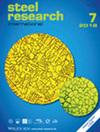P2O5 对双渣转炉炼钢过程中炉渣断裂温度和相组成的影响研究
IF 1.9
3区 材料科学
Q2 METALLURGY & METALLURGICAL ENGINEERING
引用次数: 0
摘要
本文全面研究了 P2O5 对双渣转炉炼钢过程中炉渣断裂温度和相组成的影响。利用 X 射线衍射仪和配备能量色散光谱仪的扫描电子显微镜分析了结晶相的组成和微观形态。结果表明,熔渣的断裂温度随 P2O5 含量的增加而升高。当 P2O5 含量为 2% 时,熔渣的断裂温度为 1198 ℃,当 P2O5 含量为 4% 时,熔渣的断裂温度升至 1209 ℃。随着 P2O5 含量从 2% 增加到 8%,粘流活化能呈上升趋势。在相同温度下,不同 P2O5 含量下的结晶相几乎保持不变,但衍射峰强度不同。当 P2O5 含量不变时,温度降低会导致结晶相的微观形态发生显著变化。本研究结果增进了人们对富 P 渣的了解,对优化双渣转炉炼钢工艺也具有重要意义。本文章由计算机程序翻译,如有差异,请以英文原文为准。
Investigation of P2O5 on the Break Temperature and Phase Composition of Slag from the Double Slag Converter Steelmaking Process
Herein, the influence of P2 O5 on the break temperature and phase composition of slag from the double slag converter steelmaking process is investigated comprehensively. The composition and micromorphology of crystallized phase are analyzed by X‐Ray diffractometer and scanning electron microscope equipped with energy dispersive spectrometer. The results reveal that the break temperature of slag increases owing to an increase of P2 O5 content. When the P2 O5 content is 2%, the break temperature is 1198 °C, and it increases to 1209 °C for the slag with 4% P2 O5 . With the increase of P2 O5 content from 2% to 8%, the activation energy for viscous flow shows an upward trend. The crystallized phase at the same temperature with different P2 O5 contents remains nearly unchanged, but the diffraction peak intensity is different. When the P2 O5 content remains constant, a decrease in temperature results in significant changes in the micromorphology of crystallized phases. The present results improve the knowledge about the P‐rich slag, and are also significant in optimizing the double slag converter steelmaking process.
求助全文
通过发布文献求助,成功后即可免费获取论文全文。
去求助
来源期刊

steel research international
工程技术-冶金工程
CiteScore
3.30
自引率
18.20%
发文量
319
审稿时长
1.9 months
期刊介绍:
steel research international is a journal providing a forum for the publication of high-quality manuscripts in areas ranging from process metallurgy and metal forming to materials engineering as well as process control and testing. The emphasis is on steel and on materials involved in steelmaking and the processing of steel, such as refractories and slags.
steel research international welcomes manuscripts describing basic scientific research as well as industrial research. The journal received a further increased, record-high Impact Factor of 1.522 (2018 Journal Impact Factor, Journal Citation Reports (Clarivate Analytics, 2019)).
The journal was formerly well known as "Archiv für das Eisenhüttenwesen" and "steel research"; with effect from January 1, 2006, the former "Scandinavian Journal of Metallurgy" merged with Steel Research International.
Hot Topics:
-Steels for Automotive Applications
-High-strength Steels
-Sustainable steelmaking
-Interstitially Alloyed Steels
-Electromagnetic Processing of Metals
-High Speed Forming
 求助内容:
求助内容: 应助结果提醒方式:
应助结果提醒方式:


